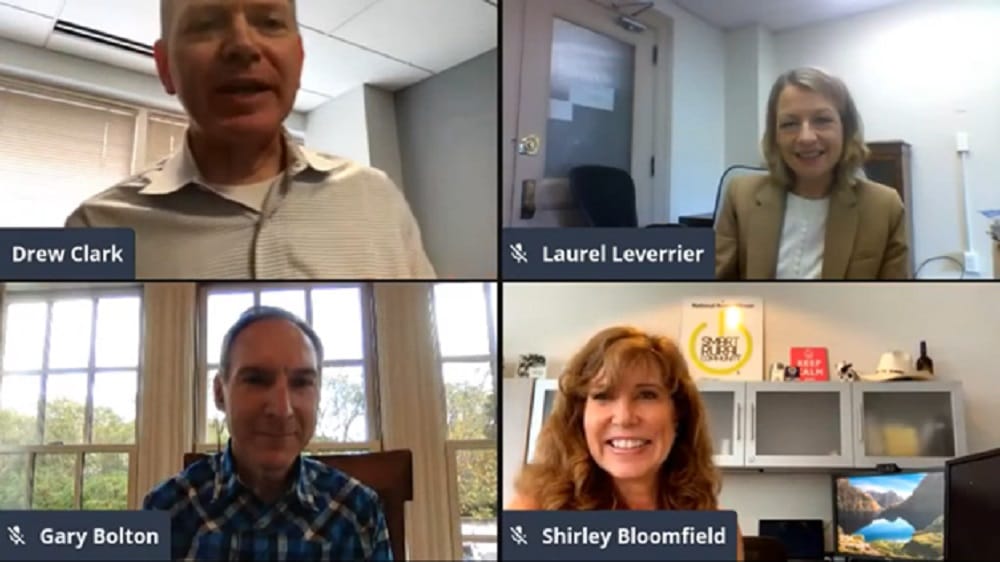At Launch of #BroadbandLive Series on ‘Tools for Broadband Deployment’, Panelists Tout Symmetrical Fiber
November 3, 2020 – Broadband networks have had their greatest challenges during the coronavirus pandemic, and sometimes fail in meeting the challenge of upstream speed needs, said Gary Bolton, vice president of ADTRAN, speaking during the kickoff event of Broadband Breakfast Live Online’s “Tools for
Liana Sowa

November 3, 2020 – Broadband networks have had their greatest challenges during the coronavirus pandemic, and sometimes fail in meeting the challenge of upstream speed needs, said Gary Bolton, vice president of ADTRAN, speaking during the kickoff event of Broadband Breakfast Live Online’s “Tools for Broadband” on October 21.
After the event that Wednesday at 12 Noon ET, Fiber Broadband Association Chair Katie Espeseth announced that Bolton had been named the new president and CEO of the association, which represents the fiber-building industry, replacing Lisa Youngers, who is going on to another opportunity in the industry.
Speaking with Bolton on the panel were Laurel Leverrier, acting assistant administrator of telecommunications programs in the Agriculture Department’s Rural Development division and NTCA CEO Shirley Bloomfield.
There have been many new entrants to the rural broadband scene recently, said Bloomfield, who was worried that these entrants set the bar too low for rural broadband quality. “We shouldn’t just say “good enough” is okay.”
Bolton also stressed the need for better broadband with higher capacities. New marketplace entrants with a community-focused approach are motivated to provide gigabit service because that’s what communities need to stay connected, he said.
USDA has pushed high speed symmetrical services from a mandate for 10 Mbps /1 Mbps
Asked by Broadband Breakfast Editor and Publisher Drew Clark about how USDA was making use of its mandate to permit broadband only in areas in which there isn’t internet connectivity available at 10 Megabits per second (Mbps) down and 1 Mbps up, and yet urge its delivery at a rate of at least 25 Mbps/3 Mbps, Leverrier said most projects are providing speeds considerably higher than the baseline.
Given the number of people who have questioned whether 25 Mbps/3 Mbps (let alone 10 Mbps / 1 Mbps) is adequate, Leverrier said the USDA adjusted its scoring metrics to give additional points to those who include 100 Mbps symmetrical service.
She said that more than 70 percent of the agency’s ReConnect projects are giving at least 100 Mbps symmetrical service.
Bloomfield acknowledged that there is not a “one-size-fits-all” solution for rural areas and that while she is a big proponent of fiber and building with the long term in mind, some communities might need to start with coverage that will have to be upgraded in two years just to get them connected sooner.
She shared that she personally prioritizes smaller carriers because they are more likely to get the job done sooner than large carriers that have a lot of demand.
Panelists agreed that the USDA has one of the best boots on the ground operations nationwide. Bloomfield held up USDA’s approach to broadband mapping as an example for how to ensure people got connected.
She also emphasized the importance of unserved areas contesting FCC maps that claim coverage in areas that are not actually covered.
Clark, referring to his experience as executive director of the non-profit Partnership for a Connected Illinois, the state broadband initiative entity, lauded the importance of the USDA’s state-wide presence in facilitating better-coordinated broadband efforts for rural America.
Although Jim Matheson, CEO of the National Rural Electric Cooperative Association was also scheduled to be on the panel, technical difficulties precluded his participation. Broadband Breakfast aims to invite Matheson for a subsequent event.
Tools for Broadband Deployment
Tools for Broadband Deployment: This series explores the way that geospatial data and asset management is shaping the future of rural network delivery and performance. This series explores how market-leading fiber builders are using digital tools to map, analyze, manage and deploy new networks – with a focus on rural success stories.
Events in “Tools for Broadband Deployment” series, which is sponsored by ADTRAN and Render Networks, include:
- Wednesday, October 21, 2020, 12 Noon ET — “Tools for Broadband Deployment: Preparing for Success”
- Are you ready for rural deployment? The United States is currently in the midst of multiple, significant efforts pushing for Better Broadband for Rural America. Think of the big picture opportunity.
- Wednesday, November 25, 2020, 12 Noon ET — “Tools for Broadband Deployment: Connecting Providers and Customers Faster”
- Case studies of network-building with an all-digital workflow. How fiber-builders are finding success in construction management, workflow processes and on-the-fly changes. In a phrase: Think workflow and business systems.
- Wednesday, December 16, 2020, 12 Noon ET — “Tools for Broadband Deployment: RDOF and Other Rural Broadband Deployments”
- The Rural Digital Opportunity Fund, the Connect America Fund and other rural deployments: How new awardees are laying the future for managing their deployments. Think managing your budget.
- Wednesday, January 27, 2021, 12 Noon ET — “Tools for Broadband Deployment: Mapping the Rural Broadband Buildout”
- Mapping broadband assets is only the first step. This session will explore how end-to-end data is showing that successful rural fiber networks begin with the end in the mind. Think broadband mapping.
- Wednesday, February 3, 2021, 12 Noon ET — “Tools for Broadband: Fueling the Fire of Rural Innovation”
- We’ll showcase how broadband deployment is accelerating the digital future for rural America at a time of COVID-19. Think success.
“Tools for Broadband Deployment” is sponsored by:

Render Networks










Member discussion